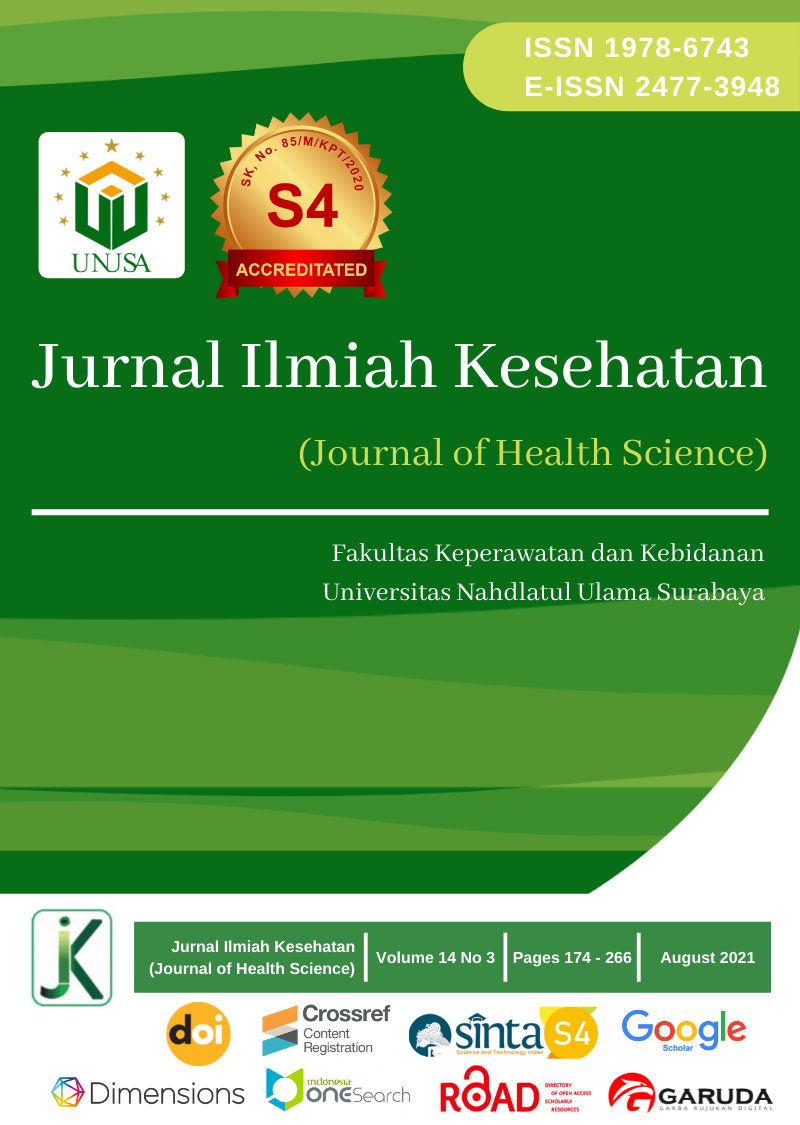Javanese Culture in Maternal Postpartum Care at Hargomulyo Village, Kedewan District, Bojonegoro Regency
Main Article Content
Abstract
Maternal and child health problems are inseparable from socio-cultural and
environmental factors in society. Factors of belief and traditional knowledge
positively or negatively impact Maternal and Child Health (MCH). Culture
could be a predisposing factor for high maternal mortality. This paper
describes Javanese culture in maternal postpartum care at Hargomulyo
Village, Kedewan District, Bojonegoro Regency. This study was descriptive
research. It took place at Hargomulyo Village, Kedewan District, Bojonegoro
Regency, from January to February 2020. The population was mothers who
have experienced postpartum both primipara and multipara. There were 48
respondents by total sampling. The instrument used a questionnaire consisting
of several questions regarding culture in maternal postpartum care, how to
carry out the culture, and its reasons. Thirty respondents did food taboos
(62.5%), six respondents limited their drinking water (12.5%), 40 respondents
drank herbs (83.3%), 47 respondents wore stagen (97.9%), and five
respondents used pilis (10.4%). In addition, 48 respondents performed
brokohan and mendem ari ari (100%), 20 respondents were not allowed to
take a nap (41.7%), and 18 respondents must be at home for 40 days (37.5%).
At the same time, 17 respondents did perineal care after birth with betel leaf
(35.4%), 12 respondents walked and sat with feet parallel (25%), and 20
respondents did semi-sitting position (41.7%). Postpartum mothers still
practice many Javanese cultures. This culture has both favorable and
unfavorable impacts on health. Furthermore, it is necessary to analyze the
influence of Javanese culture on the health status of postpartum mothers.
Downloads
Article Details
Copyright (c) 2021 Devi Endah Saraswati

This work is licensed under a Creative Commons Attribution-ShareAlike 4.0 International License.
References
Cunningham. 2013. Obstetri Williams. Jakarta: EGC.
Dewi, A. B. F. K., N. Pujiastuti, and I. Fajar. 2013. Ilmu Gizi Untuk Praktisi Kesehatan. Yogyakarta:
Graha Ilmu Hal.
Handayani, Retno. 2007. Departemen Kesehatan RI Pedoman Pelayanan Antenatal. Jakarta: Departemen
Kesehatan RI.
Kementerian Kesehatan RI. 2016. “Profil Kesehatan Republik Indonesia Tahun 2016.”
Kurniasih, Dedeh. 2010. “Sehat Dan Bugar Berkat Gizi Seimbang.”
Kurniawan, Risnayanti Anas, and Yustisia Puspitasari. 2018. “Perbedaan Daya Hambat Antibakteri
Antara Ekstrak Daun Sirih Merah (Piper Cricatum) Dan Ekstrak Daun Sirih Hijau (Piper Betle L)
Terhadap Bekteri Streptococcus Mutans (Studi Eksperimental Lab Di Laboratorium Mikrobologi
Fakultas Farmasi UMI Tahun 2016.” Jurnl as-syifa 10(01): 120 – 125,.
Marmi. 2012. Asuhan Kebidanan Pada Masa Nifas. Yogyakarta: Pustaka Pelajar.
Masita, E. D. M., and R. Amalia. 2018. “EFEKTIFITAS TRIPLE C PARENTING TERHADAP
PERSEPSI PENGASUH TENTANG OBESITAS DINI ANAK USIA 3-5 TAHUN.” Journal of
Health Sciences 11(2): 104–113.
Mochtar, R. 1998. Sinopsis Obstetri : Obstetri Fisiologi, Obstetri Patologi. Jakarta: ECG.
Pratiwi, A., and S. Arifah. 2012. “Perilaku Kehamilan, Persalinan Dan Nifas Terkait Dengan Budaya
Kesehata Pada Masyarakat Jawa Di Wilayah Kabupaten Sukoharjo.” Jurnal Komunikasi Kesehatan.
http://e-journal.akbid-purworejo.ac.id/index.php/jkk2/article/view/49.
Sari, E. D. 2011. “Pengalaman Suku Melayu Dalam Perawatan Masa Nifas Di Desa Perhiasan Kecamatan
Selesai Kabupaten Langkat.” Medan: Universitas Sumatera Utara.
Yuliyanti, L., S. K. Sulastri, and R. Faizah Betty. 2014. Gambaran Perawatan Ibu Nifas Di Wilayah
Kecamatan Miri Sragen. Surakarta: UNiversitas Muahammadiyah Surakarta.





